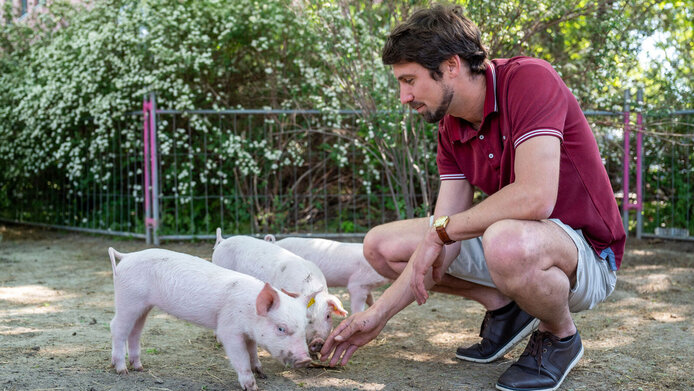How cultivating positive interaction affects pigs

The test subjects of Jean-Loup Rault are special. They learn faster than dogs and have distinct personalities. They form close friendships with their peers and enjoy interacting with people. Moreover, their brains have the same structure as human brains. As the researcher explains: “Pigs are very intelligent and have a complex social life and social behavior.” Pigs can teach us a lot about the relationship between humans and animals.
Jean-Loup Rault is an expert in animal welfare research, a field that has long been focused on recognizing stress, aggression or fear in animals. Positive emotions were not an area of interest. “Previously, there have only been a few scientific indicators that show whether an animal really likes us,” says Rault. His project “Fond of each other: Positive human-animal interactions“, which is funded by the Austrian Science Fund FWF, seeks to help close this knowledge gap.
Rault and his team want to find out which animal behaviors constitute positive interaction with humans. He is interested in learning how that affects the neurotransmitter substances in the pigs' brains in the short term and how it affects the animals' brain development and immune system in the long term. In order to find answers, he employs methods from behavioral biology, neuroscience, psychoneuroimmunology, physiology and proteomics.
With his research, Jean-Loup Rault is breaking new ground in animal welfare research, which has long concentrated on negative experiences. Together with other leading researchers, he coined the term positive animal welfare research for the first time in January 2024.
The research project Fond of each other: Positive human-animal interactions (2020-2024), receives roughly EUR 400,000 in funding from the Austrian Science Fund FWF.
Petting for science
The pigs used in this research project, which is set to run until October 2024, are German Large Whites which were born at the Medauhof, a facility operated by the Vienna University of Veterinary Medicine. After being weaned from their mothers, the four to five-week old “teenagers” are divided into groups and for a period of four months take part in various experiments.
The first experiment explores the characteristics of positive interaction. To this end, doctoral student Suzanne Truong spends time with the pigs on a daily basis over a period of two to three weeks to establish a positive relationship.
On two days, she interacts with the animals in a standardized way, petting them repeatedly for 15 seconds, followed by an equally long pause. On two days, the interaction is more spontaneous. The doctoral student pets the pigs for longer when they come closer – and also responds to their personal predilections. The pigs’ behavior is then analyzed by the researchers. “We wanted to compare these types of interaction to see whether the spontaneous approach elicits a different response,” explains Rault. At present, he and his team are interpreting the findings.
Pig brains are similar to human brains
In another experiment, Rault seeks to identify the effect of positive interaction with humans on the neurotransmitter substances in the animals' brains. “A pig's brain has the same structure as the human brain. When pigs have positive experiences, we see changes in certain regions associated with emotions, such as the amygdala,” Rault notes. This involves similar hormonal activity as is found in humans. For the animal welfare researcher to be able to measure and analyze these changes, an animal anesthetist and a veterinarian from the University of Veterinary Medicine put the pigs under anesthesia and place a catheter in the area of their spinal columns. Then the animals are given a few days to recover. Finally, postdoc researcher Oceane Schmitt interacts positively with the animals. At various intervals, a maximum of 0.2 milliliters of cerebrospinal fluid, which contains neurotransmitter substances that have been released by the brain, is then removed through the catheter. Cerebrospinal fluid is continually produced and replenished by the animal’s body.
Oxytocin and the usual suspects
“We analyze the samples for the usual suspects in terms of neurotransmitters – such as oxytocin, dopamine and serotonin,” says Jean-Loup Rault. “Oxytocin is believed to be responsible for bonding, among other things, and dopamine for the desire to do something. Opioids are usually about making you feel good about something, and serotonin is also involved in this process. We are the first to look jointly at all of these substances that interact with each other,” explains Rault. Preliminary findings indicate that dopamine and serotonin levels in the cerebrospinal fluid change after positive interactions with humans.
In addition to neurotransmitters, the cerebrospinal fluid also contains proteins. Researchers from the Austrian Academy of Sciences (ÖAW) are investigating changes in these protein levels. This is research in uncharted territory. “We want to find out whether something we don’t know about is changing – after all, there are 30,000 proteins,” notes Rault.
“This is really nice”
The third experiment turns on whether positive interactions change the pigs’ immune system and brain development. Prior to research interventions they are sedated and placed in an MRI scanner that produces images of their brains.
For twelve weeks, one half of the pigs lived without positive interactions. The other half was exposed to daily interactions with postdoctoral researcher Oceane Schmitt. At the end of the study, the animals go back into the MRI scanner. “We see that some regions are more developed or connected when the animals have had positive interactions,” explains Rault. One of these regions is the amygdala, the part of the brain that regulates emotions.
“This is really nice. It shows that we can influence how animals deal with situations or their feelings by the way in which we interact with them – and the effect will probably last throughout their lives,” says Rault. He considers this finding particularly remarkable, since the researchers interacted with the pigs for only a few minutes a day.
Focus on positive experiences
With his research, Jean-Loup Rault is breaking new ground in animal welfare research, which has long concentrated on negative experiences. Together with other leading researchers, he coined the term positive animal welfare research for the first time in January 2024. “We recognized that it's about the animal having positive experiences and positive feelings and about it having the impression of being able to lead a self-determined life,” he explains. His experiments show that humans can indeed influence how happy and content an animal feels.
Personal details
Jean-Loup Rault heads the Institute of Animal Welfare Science at the Vienna University of Veterinary Medicine, where he conducts research at the interface between physiology, animal behavior and neuroscience. He studied agricultural, environmental and food sciences as well as animal sciences and ethnology in Angers and Paris. He completed his doctorate in Animal Behavior and Wellbeing at Purdue University in West Lafayette, USA, and conducted research at the Animal Welfare Science Center at the University of Melbourne, Australia. For his work he was honored with the New Investigator Award from the International Society of Applied Ethology.
Selected publications
Rault J., Hintze S., Camerlink I., & Yee J. R.: Positive Welfare and the Like: Distinct Views and a Proposed Framework, in: Frontiers in Veterinary Science 2020
Rault J., Waiblinger S., Boivin X., & Hemsworth P.: The Power of a Positive Human–Animal Relationship for Animal Welfare, in: Frontiers in Veterinary Science 2020
Rault J.: Be kind to others: Prosocial behaviours and their implications for animal welfare, in: Applied Animal Behaviour Science 2019





